Amorim at ManU | Part 1: The Game with the Ball
The crisis at Manchester United keeps recurring. We take a closer look at the early weeks of Ruben Amorim’s tenure. In the first part of this analysis, we examine the development with the ball, carefully scrutinizing all steps taken. (MX)
After Erik ten Hag was dismissed by Manchester United’s owners, Rúben Amorim took charge earlier than expected at one of the world’s most prestigious clubs. Ten Hag, whose philosophy was heavily influenced by Ajax Amsterdam’s positional play, failed due to poor results and an increasingly unclear strategic direction. The core issues under his management were multifaceted:
- An offense lacking clear structure: Fundamental mechanisms in possession play, such as overloads or triangular formations, were missing. Instead, the focus was overly reliant on transitional moments. The connection between the lines was insufficient, which meant Onana’s qualities as a ball-playing goalkeeper were barely utilized.
- Defensive disarray and lack of compactness: Large gaps between the team’s lines emerged due to the midfield’s man-oriented pressing. This led to an inadequate rest-defense structure, with Casemiro often being overwhelmed as the lone holding midfielder.
- Lack of identity: Ten Hag adapted his playing model too much to the squad’s weaknesses, failing to establish a clear signature style. The transition from Ajax’s system to the Premier League remained incomplete, with individual dips in form further exacerbating the problems.
During his first press conference, Rúben Amorim openly addressed the challenges awaiting him at Manchester United. He directly highlighted one of the team’s main weaknesses in the possession phase, a key area of his focus: “When we talk about the team and the way it plays, I think we lose the ball too often and need to keep it better.”
He also outlined strategic adjustments, including potential changes to the base formation that seemed necessary given the player profiles available:
“There is a way we’re going to approach this, and we’ll have to adapt some players because we don’t have the right profiles. This team was built for a different system, but as I’ve said before: whether you play with a back five or a back four, the principles remain the same. Only the positioning changes slightly.”
The starting situation for Amorim could not have been more difficult: no pre-season, only two weeks during an international break with many key players unavailable, and a challenging run of fixtures against top-tier opponents looming. Despite these circumstances, the new coach remained optimistic, stating:
“I believe in this—call me naïve—but I genuinely feel that I’m the right man at the right time.”
A few weeks later, the mood has drastically shifted: Amorim is already under significant pressure. This provides us with an opportunity to take a closer look at an intriguing manager and a unique club. Our tactical analysis of the key problems during Rúben Amorim’s early tenure will be divided into two phases, which we will explore across two articles:
- Phase 1: Ipswich, Bodø/Glimt, and Everton – A Promising Start
- Phase 2: Nottingham and Arsenal – The First Real Tests
- Phase 3: Derby Victory and Spectacle in the EFL Cup
- Phase 4: Already a Threatening Losing Streak?
The Two Overarching Themes of the Articles:
- 1: Play in Possession
- 2: Off-the-Ball Play Combined with Transitional Moments
Phase 1: Ipswich, Bodø/Glimt, and Everton – A Promising Start
Ipswich Town v Manchester United (24.11. – 1:1)
Right in his first game against the promoted Ipswich, Amorim fielded a rather intriguing formation with a remarkable selection of personnel—just as he had hinted during his first press conference. For the first time, the Reds operated with three nominal central defenders. Evans, Mazraoui, and de Ligt formed the first line in the center. Casemiro and Eriksen played as central midfielders, while Dalot and Diallo occupied the wing-back roles. Fernandes and Garnacho operated as half-space playmakers, with Rashford leading the line up front.
United Deep in a 2-4-2-2
The buildup play bore notable resemblance to what Amorim had already implemented in Portugal. United operated out of a 2-4-2-2 setup, with de Ligt acting as the second central player alongside Casemiro, while Eriksen advanced into the left half-space next to Fernandes.
Ipswich pressed in a 3-4-1-2 system, though they had to deal with numerical inferiority against United’s double pivot. The right forward, Hutchinson, was tasked with keeping de Ligt in his cover shadow but also had to curve his pressing run to close down Evans early. The moment de Ligt moved out of the cover shadow, United deliberately looked for a long ball from Onana, who held the ball patiently, aiming for the slightly freer de Ligt in a central position. These movements appeared well-prepared and coordinated. Through this route, United repeatedly managed to exploit Mazraoui’s flank via triangular combinations, which Ipswich initially sought to isolate.
The dropping movements of the half-space playmakers Eriksen and Fernandes were also striking in this system. Time and again, they were able to receive the ball directly and then, for example, play forward through the overlapping full-backs via layoff passes. The ball play of the wing-backs also repeatedly showed diagonal shifts to the width, providing valuable support. This was especially effective as Ipswich’s wide players usually pressed Dalot and Diallo from a rather diagonal angle. Therefore, the pass to the wide areas was often possible without any issues.
Especially Garnacho occasionally dropped back or moved to the side. He often dragged a centre-back out wide, creating space for Rashford in behind, who then frequently looked for it. United then sought the long ball to him. The playmakers would occupy the center forward position when needed – particularly after breakthroughs into the final third – while the wing-backs alternated between a position near the back three in buildup and a very high position in the final line.
Ipswich’s 3-4-3 had significant access problems overall. The wide players had to either step out far and then shift strongly inward to mark United’s half-space playmakers. As a result, the space next to the back three often remained unoccupied. The opening goal came from a situation where Fernandes pulled t Davis out wide, creating space for Diallo in between, who could then sprint into the depth with his high speed.
Ball-far, the wing-back repeatedly moved into the box, creating an impressive presence in the penalty area, as seen in the goal. Particularly noticeable was the immediate forward movement of the ball-far full-back into the last line after switches of play. This pattern was promising multiple times, but it often failed, especially with Dalot, due to his weakness in direct duels.
3-1-2-4 in Higher Build-Up
In the higher buildup play, de Ligt positioned himself between the half-backs Evans and Mazraoui, creating a structure that alternated between 3-1-2-4 and 3-2-5, which closely resembled Amorim’s Sporting setup. This flexibility stemmed mainly from the dynamic movements of Casemiro, Fernandes, and Eriksen. Occasionally, they operated with a double pivot of Casemiro and Eriksen, while at other times, the formation followed the pattern seen above. In some situations, Fernandes dropped back as the third defensive midfielder, while in other moments, he also operated in the last line.
The main goal in United’s higher buildup was to tie Ipswich’s wide forwards from their 5-2-3 formation with the central midfielders Eriksen and Casemiro, in order to create space for the centre-backs Mazraoui and Evans to drive forward with the ball. This concept worked well at first, with Mazraoui often managing to position himself in promising starting positions in the half-space.
However, the momentum shifted in favor of Ipswich, which was due to two factors. First, Fernandes was now directly tracked by the centre-backallowing Ipswich’s second central midfielder to more closely mark either Casemiro or Eriksen. This prevented the midfielders from continuing to tie up the wide forwards, allowing them to instead press the centre-backs.
Second, Ipswich managed to press players like Fernandes or Diallo directly after their dropping movements with diagonal pressing angles. The defenders followed closely and were immediately engaged in duels, which increasingly troubled United. Additionally, Ipswich often closed passing options to the back, causing United’s buildup to stall and allowing Ipswich to launch more counterattacks.
Problems in Width
Even in the first match, a significant individual tactical issue became apparent: The wing-backs Dalot and Diallo struggled to turn under opponent pressure from the wide areas and move toward the opponent’s goal. This weakness led to frequent breakdowns in buildup play at these positions. It remains to be seen how this issue will be addressed moving forward, especially in terms of squad planning, as this role is crucial for structural buildup.
Additionally, another structural problem was evident in the interaction between midfield and wings: alongside Eriksen, Casemiro operated, but his strengths, particularly in pushing out to the wings, did not have the desired effect. Amorim prefers players in these roles who immediately engage in 1v1 situations under direct pressure and look for dribbles into the half-spaces. These actions are intended to open up the half-spaces through overloads in the last line, which Casemiro was less effective at executing.
Manchester United v Bodø/Glimt (28.11. – 3:2)
Fernandes as a Key Player
The most notable tactical change came against Bodø/Glimt in the Europa League, particularly in the personnel choice: Fernandes was now deployed as a central midfielder, which made the buildup play more dynamic and flexible. This decision had an immediate positive impact on the game. While the individual issues of the wing-backs remained, Fernandes’ presence in the center ensured that the full-backs—especially on the left side—received more support, thus expanding their options in buildup play. His movements added more stability to the ball circulation.
On several occasions, he was able to generate dynamism unchallenged from his central position. This was possible because Garnacho, in his deeper position, occupied Glimt’s right midfielder, while Ugarte engaged the other central midfielder. Additionally, Højlund, by occasionally dropping deep, ensured that the remaining central midfielder was also occupied. As a result, Fernandes repeatedly found space in the half-space and was able to launch decisive forward movements from there. This pattern was a key factor in United’s improved possession play against Glimt.
Another noticeable individual tactical element was the way Fernandes repeatedly dropped behind Bodø/Glimt’s first pressing line. This led to United operating in a kind of 4-1-5 system at times. The aim appeared to be creating a 4v3 overload against Glimt’s man-oriented pressing. This structure worked largely well as it helped spread United’s centre-backs into wider positions. This, in turn, weakened the pressure from Glimt’s three forwards on the buildup, reducing the defensive pressure on United’s backline. The adjustment allowed United to switch the ball into wider areas and create space to bypass the opponent’s pressing.
2v1 Overload on the Wings
Against Bodø/Glimt, there was a clear difference in the defensive structure of the visitors compared to Ipswich. The Norwegians played in a 4-3-3 formation, which allowed United to repeatedly create 2v1 overloads in wide areas. By tying up the opposing full-backs in the half-space, United had the opportunity to position Antony and Malacia much higher. Unlike against Ipswich, they no longer had to drop deep, but could instead receive passes directly in the forward movement and exploit the tempo from the created overloads.
In the deep buildup, United operated with a slightly adjusted 2-3-2-3 system, aiming to create compact structures through ball-near movements and facilitate buildup through the center. Antony and Malacia, as well as the centre-backs, looked for passing options from higher positions, while Fernandes, Ugarte, Garnacho and Mount formed a diamond-shaped structure to create tight connections and dynamism in the buildup play.
The 2vs1 on the wing played a key role again here. Particularly when the full-backs dropped deeper, as seen with Malacia, the Bodø/Glimt full-back often stepped out aggressively in a diagonal direction to apply pressure. However, this created space for Garnacho, who initially found himself without a direct opponent. Højlund occupied the centre-back with his close positioning, while Fernandes’ ball-near shifts engaged the central midfielder of Glimt. As a result, the wide midfielder for Bodø/Glimt had to defend in behind to prevent Garnacho from receiving the ball. Despite this, Garnacho repeatedly managed to find space and be played into the half-space, giving United valuable dynamism in their buildup play.
On the far side, the movements also posed challenges. Mount often shifted into the center, while Antony advanced to the last line. These adjustments created 2v1 situations as Bodø/Glimt’s full-back frequently followed Mount inside. As a result, Antony was diagonally freed in some situations, providing additional options for the build-up play.
Bodø/Glimt Finds Solution, United’s Problem Persists
Bodø/Glimt initially struggled to gain control against United. It wasn’t until Helmersen, the central forward, focused almost exclusively on Fernandes, marking him continuously, that they managed to somewhat disrupt United’s overload. However, this tactical approach created space centrally, allowing De Ligt to operate freely. In advanced positions, De Ligt was able to make several unchallenged passes, switching the ball between the centre-backs.
The issue, however, remained that United was often isolated in wide areas. Antony, in particular, struggled in the isolated 1v1 duels, losing the ball 12 times, which unsettled the team. The coordination between full-backs and half-space-10s in the 2v1 situations was also not ideal—often lacking depth or arriving too late. Eventually, United resorted to more long passes to Højlund from the wide areas, rather than solutions through short passing.
Glimt mostly created offensive opportunities through ball recoveries. This was clearly related to United’s man-oriented counterpressing, which often failed to win back the ball after diagonal switches and lacked collective coverage around the ball. Additionally, the transition into a structured defense seemed poorly defined.
Manchester United v FC Everton (01.12. – 4:0)
Amorim switches to a 3-5-2
In the next game, United and Amorim achieved another victory against Everton. Amorim adapted the system in the higher buildup to a 3-5-2, with Fernandes nominally intended as a half-space number ten but almost continuously playing alongside Casemiro as the left eight. Sean Dyche, similar to Bodø/Glimt earlier in the week during the second half, pursued a clear strategy: focusing on closing down the center while simultaneously creating 1v1 situations against the full-backs.
In this process, striker Beto was specifically tasked with isolating De Ligt, the central centre-back, by shifting horizontally. The centre-backs Mazraoui and Martinez were continuously pressed by the wide players of the 4-2-3-1. The ensuing pressure—both from the sides and diagonally—significantly hindered United’s buildup. Often, the only option left was the pass to the dropping full-backs Diallo and Dalot, who, however, were aggressively attacked by Everton’s wide players.
Dalot and Diallo avoid 1v1
A central theme in the game was United’s attempt to avoid 1v1 situations in the wide areas and instead, with the first touch, play directly into the space between the lines. In these spaces, the forwards Zirkzee and Rashford moved, which led to several dangerous situations. These actions were structurally prepared from a deeper starting position, instead of dynamically, as in previous games. This often led to a certain distance between Everton’s full-backs and the dropping wing-backs, which Diallo and Dalot could have exploited with quick passing.
In practice, however, it was particularly difficult for Dalot to play the demanding pass cleanly under pressure when dropping. He lost the ball in these situations several times. Similarly, with Diallo, it sometimes appeared as if he instinctively preferred to go for the 1v1 rather than looking for the quick support. As the game progressed, it also became clear that neither Zirkzee nor Rashford were ideal for wall play and holding the ball in these situations. This repeatedly led to problems in counter-pressing, as the direct follow-up from the midfield was often missing.
Through this approach, United was repeatedly able to win the ball directly in the final line and generate a lot of dynamism through the tightly linked duo of Rashford and Zirkzee. It became particularly dangerous when the far-side, pushing full-back was involved in the play. This opened up additional spaces and made the attacking play more unpredictable.
Mainoo appeared to be a game-changer in this match. Similar to Fernandes earlier, he frequently dropped in front of the opponent’s first pressing line, creating a wider back four in the buildup. After his passes, he immediately surged intensively into the half-space and up to the final line. This created two advantages: first, Everton’s pressing mechanisms were at times neutralized, as the additional player made it more difficult to assign coverage in the 4-2-3-1, particularly in terms of pressing the wide centre-backs. Secondly, the centre-backs Martinez and Mazraoui were given more time, benefiting from the reduced distance and better passing angles to the full-backs. This made the buildup more controlled and structured overall. In some situations, the full-backs pushed directly into depth, allowing them to be played into these spaces and bringing additional dynamism to the attack.
Interim Conclusion 1: United remained unbeaten in the first three matches under Ruben Amorim. However, this success can also be attributed to the quality of the opponents, who cannot be considered a true benchmark for United and their new coach. The structural issues, particularly in the full-back positions, could not be sustainably solved during the first English week. Initially, they tried to cover the width with the 1v1 specialist Antony, but then switched to an approach that directly targeted the space between the lines, preparing it through the positioning of Zirkzee and Rashford. This approach worked in phases but revealed adaptation difficulties from the players, who were not yet fully comfortable with it.
Some minor tactical adjustments, such as Fernandes’ breakthroughs or Mainoo’s dropping deeper, proved to be momentum-changers at least. Nevertheless, the victories were also heavily influenced by mistakes from the opponents, particularly in buildup play. More on that in Article 2.
Phase 2: Nottingham and Arsenal – The First Real Tests
After the two convincing victories, euphoric voices emerged, particularly in the yellow press, which promptly placed United back in the elite circle of European top clubs. Whether these assessments were justified would be revealed for the first time at the Emirates Stadium against Arsenal.
Arsenal London v Manchester United (04.12 – 2:0)
United Now in a 3-2-5
Amorim adapted to a 3-2-5 with somewhat deeper central midfield players, which was almost identical to the previous 3-5-2, while Arsenal – similar to Everton the previous week – pressed from a 4-4-2. For the first time under Amorim, Maguire started, and Arsenal took advantage of this. Kai Havertz pressed him aggressively and ran in a curve to isolate the central centre-back when the full-back had possession. The wide players, Saka and Martinelli, advanced to press Mazraoui and De Ligt. Their starting position was deliberately chosen to be very wide in order to block the passing lanes to the wing-backs early on.
Mazraoui and De Ligt were forced to play into the pressure through the half-space more often. On the right side, the passes often went to half-space number ten Mount (marked by Rice), while on the left side, the pass into the half-space was directed towards the dropping striker Garnacho (marked by full-back Timber). Fernandes typically played more centrally and closer to the ball. Amorim’s plan seemed designed to bind Timber with Garnacho’s drop, creating space for the quick Malacia and generating a 2v1 overload against Timber. However, this space was often inaccessible as Saka, due to his positioning and the shadow of coverage, frequently blocked the passing lane, preventing Malacia from receiving the ball.
Garnacho and Mount found it difficult to secure the ball or make effective turns, largely due to Arsenal’s dynamic pressing, which disrupted United’s attempts to build through the middle. Arsenal’s central midfielders, particularly the sixes, added complexity by stepping out to pressure United’s half-space players, further intensifying the pressure on Mount and Garnacho. The expected distribution of the ball to the advancing full-backs, a strategy seen in previous matches, was rarely observed. When this did happen, it typically came from a deeper position by Malacia, but even here, Saka’s quick movement allowed him to close down the pass, making it difficult for United’s full-backs to escape and progress the ball into the final third.
Arteta incorporated flexible alternatives into his pressing scheme that specifically targeted United’s tendencies in buildup play. When Fernandes or Ugarte dropped deep in front of the pressing wall—a movement that had posed significant challenges for previous opponents—Arsenal was well-prepared. Havertz took up a direct marking role on the dropping player, while Partey positioned himself tightly on the remaining central midfielder. Meanwhile, Ødegaard assumed a hybrid role, running in a wide arc towards Maguire, allowing Arsenal to not only press the center but also the half-spaces. This coordinated pressing scheme significantly restricted United’s options, preventing them from developing controlled build-up plays through the intended deep dropping movements meant to relieve pressure.
Arsenal did not always press the half-backs with full intensity but often maintained a wide defensive shape to block passing lanes to the flanks without directly engaging. This more restrained approach proved effective, as it allowed Arsenal to control United’s build-up while not exposing their own pressing system. In response, United’s full-backs Dalot and Malacia often dropped deeper to escape the covering shadows and make themselves available for passes. While they looked for passes into the deeper areas, these attempts often encountered problems. Arsenal’s wide players and full-backs applied immediate pressure, making it difficult for Dalot and Malacia to progress the ball cleanly or escape these tight situations.
The solution, similar to the Everton game, was often to play directly into the half-spaces. United attempted to bring in Højlund, a striker capable of better hold-up play than Zirkzee, to facilitate this. While it worked intermittently, there were still issues: Garnacho too often remained too wide and did not shift closer to the ball, instead positioning himself near the far-side centre-back. Arsenal reacted quickly, closing the centre whenever balls entered the half-spaces, making it nearly impossible for United to follow up.
As the full-backs often received the ball from deeper positions, they could not generate width or depth, leading to only direct options under pressure in the centre. Højlund was thus forced to turn first to release a pass under pressure, but Kiwior and Saliba effectively neutralized this threat. The tight defending and quick reactions to United’s attempts to switch the play made it extremely difficult for them to progress the ball into key areas.
Changes and Deep Build-up Problems
As pressure mounted and ball losses increased during the build-up, Manchester United began to rely more on backward passes to André Onana to reestablish control from a deeper position. In response to Arsenal’s high press, United shifted their usual 2-4 build-up formation into a 3-4-3 setup. Harry Maguire moved alongside Onana as a right centre-back to provide more stability in the centre.
However, the spacing in the goalkeeper’s chain was problematic at first, particularly on Mazraoui’s side. Malacia, as the only wide option, was often positioned too high, isolating him in Saka’s covering shadow. On the right, the compact positioning of De Ligt and Dalot caused the field to narrow significantly. United tried to build through Mazraoui, but this strategy proved vulnerable: often, due to Malacia’s positioning, Mazraoui had to play a backwards pass to Onana, who was under pressure from Martin Ødegaard. Havertz anticipated possible passing options, further hindering the build-up.
As the first half progressed, Arsenal’s pressing became increasingly problematic for United. The visitors formed their attacking press in a 4-1-3-2 shape, directing United’s ball circulation to the full-backs. These were isolated by man-marking shifts from Saka and Martinelli. Declan Rice, as the lone defensive midfielder, followed Mount in the half-space, while Partey pressed the ball-carrying midfielders Fernandes or Ugarte. United struggled to solve these tight man-marking setups combined with vertical passing lane blocks. Forced, uncontrolled clearances led to turnovers, making it harder to establish a structured build-up.
An improvement came when Malacia adjusted his position deeper around the middle of the first half, better integrating into the build-up. With his support, United regained more control in the build-up, returning to a shape closer to the original 2-4 system. However, they remained vulnerable to Arsenal’s aggressive pressing and central blocks.
Later, Amorim made another adjustment by switching Diallo with Dalot and pushing them higher, positioning De Ligt as a nominal right wing-back in the 2-4 build-up. Despite this change, the fundamental problem in the shallow build-up remained: United still had significant difficulties handling pressure on Dalot and De Ligt. Arsenal’s wide players Saka and Martinelli kept their covering shadows on Mount and Garnacho. These two players often stayed close to the ball instead of stretching the field – a change that could have been more effective against Arsenal’s diagonal pressing angles.
The occasional exploitation of the 4v2 overload on the right side, particularly through diagonal passes from Onana or after multiple phases, failed to yield significant success. Arsenal’s precision in their pressing structure – with full-backs closing down Diallo, central defenders covering Mount, and wide players shutting down De Ligt – was so seamless that United could not generate any real dynamism. The ball often ended up with Malacia, who was isolated on the wide areas and had few passing options available.
The lack of coordination in the offensive players’ movements became even more apparent. Højlund, although looking to make runs into depth, was often caught offside by the time the ball reached Malacia, which meant a crucial depth option was missing. The ball-near movements of the attacking midfielders often came too late, which caused those passing options to be lost as well. Mount could have made runs into the depth at times, but his movements were late, allowing Kiwior or Rice to take control of him early. As a result, despite the tactical adjustments, United remained largely ineffective, especially in situations where the ball could have been played quickly behind Arsenal’s defensive line.
Eventually, especially after conceding goals, United moved further away from short-passing in both build-up structures. Instead, they pushed their full-backs and half-space attacking midfielders higher up the pitch to create 2v1 situations in the wide areas and aimed to exploit them with long passes from Onana or the centre-backs. This approach worked intermittently, and Diallo was put in good 1v1 situations, but Arsenal continued to dominate, especially with their defensive line repeatedly defending very well.
Rice and Partey shifted excellently to the ball side following long passes, enabling them to win second balls on multiple occasions. In contrast, United’s large gaps between the lines became an increasing problem, as they lacked compactness to effectively win second balls or progress play in a controlled manner. This led to Arsenal gaining more control of the game, and their dominance culminated in a 2-0 victory, with both goals coming from set-pieces.
Manchester United v Nottingham Forest (07.12.; 2:3)
After the defeat in London, Manchester United was unable to secure any points against Nottingham Forest either. Even before the team could register its first possession phase, they found themselves trailing. As a result, the need to generate successful ball progression was even more important.
New Personnel Arrangement
United adopted a similar approach to the previous week, albeit with personnel adjustments. For the first time this season, Ugarte and Mainoo started together in central midfield, while Fernandes operated as a half-space playmaker in the right half-space. It quickly became apparent that Nottingham applied a highly pass option-oriented pressing from their 4-4-2 shape. United’s back three was hardly directly pressed in their base formation, as the two forwards focused on covering the central passing lanes, while the other players took on man-marking roles.
United’s game plan was to counter this conservative defensive pressing by having the left centre-back, Martínez, dribble diagonally to pull Nottingham to one side and free up the far zone. Initially, this was meant to benefit Yoro, and ideally, later also Fernandes, who would shift outwards. A key question is how much the inclusion of Yoro as the right centre-back and Fernandes’ role in the right half-space were explicitly tied to this plan.
The three-man defense line was significantly wider compared to previous matches, with noticeably larger gaps between the centre-backs. De Ligt and Yoro positioned themselves deeper to be more receptive to switches within the back three. Fernandes moved early in the ball-far half-space, pulling away from his direct marker Yates to receive the ball and initiate the buildup. This movement was supported by Højlund, who frequently dropped slightly deeper to bind Yates and disrupt his pressing. As a result, the left side often featured a 5v5 situation, while the right side had a more straightforward 3v3.
Nottingham quickly adjusted to this setup. From their 4-4-2 formation, they shifted to a 4-3-3 by moving Hutchinson higher from his usual winger position on the ball-far side. This allowed him to immediately pressure Yoro when he was in possession, significantly reducing Yoro’s decision-making time. As a result, Yoro struggled to play passes to Diallo or Fernandes, as both were already positioned high, preparing for a transition and moving out of the immediate passing range.
United responded with two adjustments: First, Yoro dropped even deeper to shake off Hutchinson, but Hutchinson followed him closely, and eventually, Yoro was positioned so deep that a pass to him was no longer possible. Second, Diallo stopped playing wide on the last line as in previous games. Instead, he dropped deeper to offer himself as a direct passing option. This adjustment worked well early on, as Fernandes pushed forward, engaging Forest’s left-back, who didn’t follow Diallo. This allowed Diallo to drive the ball forward unchallenged.
However, the main issue was finding opportunities to get Diallo into these situations more frequently. Yoro’s increasingly deeper positions affected the height of the back three, reducing the dynamism of lateral dribbling moments. Furthermore, Yoro began adopting an unhelpful body posture, signaling that he didn’t want to receive the ball. His body was mostly oriented toward his marker Hutchinson, highlighting his uncertainty in these situations.
On the left: Square Binding through Square Overload
As a result, the plan to “pull to one side and resolve on the ball-far side” was no longer pursued. Instead, United shifted to directly creating overloads. One way this was achieved was through Martínez’s dribbling, which was often possible even quite deep, as Garnacho would frequently try to bind Forest’s left-winger to prevent him from pressing Martínez. With Forest’s defensive line already relatively compact, Martínez was often able to pass to Dalot in the width. Additionally, movements from the width came into play—typically in the simplest form, this involved Garnacho dynamically running through the half-space and then receiving a pass into depth. The advantage of this wing play was that the opponent could initially be pushed back without much risk, which could then be used to transition the ball into more dangerous zones.
The movements from the wide areas were supported by a clear structure: through the positional 3-2-5, a square was formed by Martínez, who dribbled and stayed high (binding the ball-near striker), Garnacho in the half-space (binding the ball-near central midfielder), the centrally oriented Ugarte (binding the ball-far striker), and the dropping Højlund (binding his man-marker, Yates) to overload the wing. At the center of this square was Mainoo.
The concept aimed to occupy the opponents of the 4-4-2 system with these bindings and present Mainoo as a free player when he came to meet the ball diagonally. This build-up plan worked particularly well because the overload on the ball-near side shifted Nottingham’s focus, allowing a 3v2 overload on the far side through Diallo, Fernandes, and Yoro in the final third. Mainoo could quickly be played as a central point to distribute the ball to the far side. His excellent initial movements and ability to quickly turn with the ball under pressure made him a key player, as Nottingham struggled to react effectively to the quick switches.
Right: Layoff play with good follow-up movements
United also showed improvement in dealing with layoff plays against a more conservative pressing, like Nottingham’s. Especially De Ligt, as the central centre-back, often made diagonal runs — like in the 1:1 situation — to create a passing angle that allowed him to target the dropping Fernandes. Since Nottingham did not consistently play man-oriented in the defensive midfield but instead often tried to gain access through the strikers’ cover shadows, interesting opportunities arose to exploit these gaps.
In the first half, United effectively exploited the space in the half-spaces, particularly through the deep dropping of players like Fernandes. This allowed Ugarte to be played into forward progression through simple layoff passes, bypassing Nottingham’s press. Ugarte, unmarked in central areas, was able to push forward and initiate dribbles, often finding Garnacho in deeper runs to exploit spaces in the attacking third. These sequences were enabled largely by Højlund’s deep positioning, which continually occupied Yates and opened up central space.
Fernandes also played a crucial role in bypassing Nottingham’s pressure, particularly on the right side, where he used layoff passes to get Diallo into 1v1 situations against Forest’s full-back. Fernandes’ ambidexterity allowed him to seamlessly switch the play and make quick decisions, driving these moments forward.
Problems against the 4-2-3-1
However, after Nottingham’s tactical shift to a 4-2-3-1 around the 35th minute, United began to struggle. With the wide attackers dropping deeper, the half-spaces became congested, and Fernandes’ movements were closely tracked, limiting his ability to link play. The intensity of the pressing on United’s back three also increased. While De Ligt remained unpressured, the wider centre-backs were forced to play under pressure as Nottingham’s wingers began to close them down more effectively. This disrupted United’s ability to progress the ball through the wide areas, especially for Yoro and Martínez, who found it harder to push the ball forward.
The second half was increasingly frustrating for United, with much of their play becoming stagnant on the left side. Nottingham’s 4-2-3-1, particularly through the compactness in midfield and the loose man-marking of Ugarte by Wood, stifled United’s central progression. Consequently, United had to resort to riskier strategies, often relying on diagonal balls to the far side where Rashford’s pace could create overload situations. However, these moments were undermined by a lack of precision in the final third. Key situations, such as the interplay with Højlund and Garnacho, lacked accuracy, and the Reds struggled to make the most of promising transitions.
Interim Conclusion 2: Manchester United finishes their first tests under Ruben Amorim without any points, which increases the pressure on the team. What can be deduced from their possession play? The initial plan generally works well, especially in the early minutes when United can regularly dominate. This suggests that the fundamental game concept is effective. However, weaknesses become apparent when adjustments to the opponent’s tactical changes are required. This points to mechanisms that are still not fully developed.
Additionally, the execution of specific movement patterns, especially in terms of timing, is often still messy. The half-space players Fernandes and Garnacho possess the necessary qualities for the type of layoff play Amorim prefers, but they struggle significantly when forced to play under pressure from behind. This was already an issue against Arsenal and became evident again after Nottingham’s tactical adjustments.
The strategy of engaging the opponent’s six by having Højlund drop deeper is a sensible approach, but it comes with the drawback that he is absent as a target player in the box in certain situations. The challenge remains to find this balance and improve reactions to opposing adjustments.
Phase 3: Derby Victory and Spectacle in the EFL Cup
Following recent tests, Manchester United now faces two significant challenges. On the one hand, there’s a knockout match in the EFL Cup against Tottenham, where Amorim’s team is under increased pressure not only to perform tactically but also to deliver mentally and produce results. On the other hand, the prestigious Manchester derby follows, which holds special significance not only due to the rivalry but also as a benchmark for assessing the progress made under Amorim. Both games will determine whether United can address the identified weaknesses in possession play and in handling tactical adjustments from opponents in a timely manner or whether these issues will persist.
Manchester City v Manchester United (15.12 – 1:2)
Midfielders systematically deeper
In the build-up phase, predominantly observed during the early stages against Manchester City, Amorim deployed a 3-1-4-2 formation, characterized by asymmetrical wingbacks. The ball-near wingback pushed extremely high and wide onto the last line, attempting to break free from the cover shadow of City’s wide player. However, in practice, this positioning often proved unplayable. Mazraoui and Dalot filled the wingback positions, while De Ligt shifted into a half-back role for the out-of-form Yoro. Maguire started centrally in the three-man defense, and Diallo, compared to previous matches, played as the right forward.
Importantly, the half-space players were positioned much deeper than in previous games. While they still dropped back dynamically, this movement appeared more structured, originating from a set starting position in this match. This could reflect a lesson learned from the Nottingham game: offensive players generating dynamism also creates dynamism for the defensive players, something Fernandes had struggled with in earlier encounters.
As the game progressed, it quickly became evident that City effectively shut down the half-space and central areas with their 4-2-3-1 mid-block, using a blend of cover shadows and man-marking. The central defenders, in particular, struggled to find creative solutions, often resorting to back passes to Onana. A structural issue became apparent early: when the central midfielders dropped too deep, there was a lack of support in the presence zone for second balls, isolating the target player in the center-forward position. Martinez frequently hesitated to play the ball to the aerially strong Højlund, knowing that doing so without adequate second-ball support would lead to his isolation.
The long ball to Højlund was rarely used in the early stages. Diallo, known for his burst of speed, could have made deeper runs to exploit this option and potentially destabilize City’s structure.
Circulating the ball within the back three also proved ineffective, as City isolated United’s far-side centre-back by positioning their far-side winger higher, cutting off potential switches of play—a tactic successfully employed by several opponents. Consequently, United often had to revert to a deep build-up, as alternative solutions were scarce.
Problems against shifting City
United responded with a 2-4-2-2 build-up, to which Manchester City countered with a 4-2-4 pressing shape. Walker, nominally a right-back, marked Mount man-to-man in the second pressing line, creating a 3v2 overload in the center. This could also be described as a 3-4-3 pressing structure.
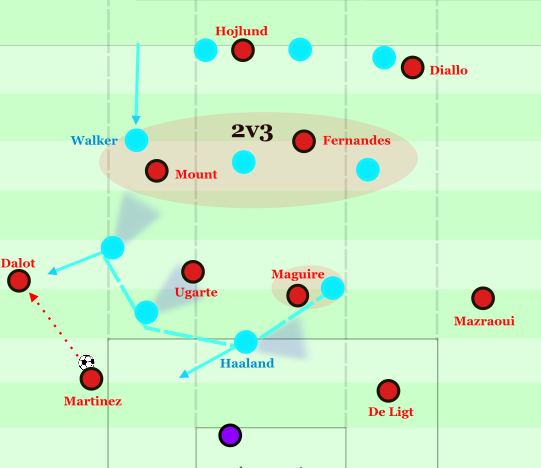
The first pressing line of Manchester City did not aggressively press the centre-backs Martínez and De Ligt but instead focused primarily on efficient shifting. The half-space players, Mount and Fernandes, as well as the ball-near central midfielder—often Foden—were shielded through cover shadows. Meanwhile, the second striker, typically Haaland, loosely covered the ball-far centre-backwith his slightly higher positioning, preventing United from playing back passes. Onana was often reluctantly involved in these deep build-up phases, likely due to concerns that City could trigger an aggressive press through short distances.
This pass-options-oriented pressing frequently forced United to play to the full-backs. The half-space positioning of City’s wide players facilitated this. However, once the ball was played to the full-backs, City quickly regained control. Martínez was consistently closed down, and the ball-far striker, Haaland, isolated the passing lanes back to the centre-backs with his movements. This strategy was highly effective and often forced United into long passes.
In the first half, United attempted to address this issue by having Mount drop wider, aiming to stretch Walker’s positioning. However, this adjustment proved largely ineffective, as Walker tracked these movements closely. Additionally, City’s numerical superiority in the center allowed them to quickly close any gaps in the half-space, preventing the desired effect of “stretching” the center.
Mainoo shifts wider
Mason Mount had to be substituted early due to injury, with Mainoo coming on in his place. Mainoo then swapped positions with Fernandes, moving to the right side. Towards the end of the first half, an apparent diamond shape emerged, with Diallo occupying the wide position. This double width allowed Mazraoui to drop slightly deeper, making it more difficult for City to isolate him through their pressing and half-space focus. As a result, Mazraoui became more available for passes and utilized the connection with Diallo as a vertical outlet.
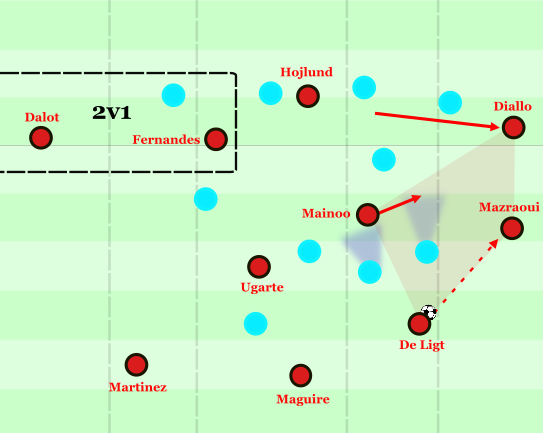
The main issue with this approach was that Diallo seemed uncomfortable in tight situations requiring quick turns, as his strengths lie more in dribbling or making runs in behind. Nunes, who closely tracked Diallo’s movements, largely neutralized this threat. There was potential to involve Mainoo’s off-the-ball runs through quick lay-offs, similar to the approach against Nottingham, but this pattern was largely absent, as Mazraoui often had to play with his weaker left foot, which caused him difficulties.
Diallo’s best offensive moments came from diagonal switches, where United repeatedly sought a 2v1 situation against City’s wide full-backs. These opportunities arose because the distance from the wide positions to the centrally positioned defenders created 1v1 dribbling situations for Diallo, where he could exploit his strengths. Towards the end of the first half, these switches became increasingly forced. However, on the right side, they worked more effectively, as Mazraoui and Diallo provided better vertical distribution. In contrast, Dalot and Fernandes on the left often aligned horizontally, making it easier for City to disrupt the dynamic with quick shifts.
Changes in the Second Half
After the early deficit in the first half, it became clear that an adjustment was necessary to prevent Amorim from coming under pressure early in his tenure.
This change came relatively quickly, as United began to adopt a 2-4-3-1 shape in midfield. The central defenders, De Ligt and Martínez, became more spread out, moving higher and wider, which facilitated this shift.
City responded by switching to a 4-3-3, which created better pressing angles against Dalot and Mazraoui in the half-spaces, as opposed to their initial 4-2-3-1 pressing, which had focused more on the wide players. This tactical adjustment made sense because, in the first half, there were moments when Mazraoui, in a high position, could have bypassed his marker, Doku. However, Mazraoui was rarely found in these situations due to the poor coordination with De Ligt’s advancing movements, leading to awkward passing angles.
Pep’s change was partly driven by Dalot’s high positioning on the opposite side, combined with Fernandes and Mainoo’s off-the-ball movements, which often pulled City’s central midfielders out of position. This created an exposed six-space, which City tried to compensate for by dropping Gündogan deeper to block potential passing lanes to Højlund. This allowed City to gain better access to the wide players.
On United’s side, adjustments were visible as well. The formation resembled a 2-4 shape, with the ball-far centre-back pushing higher and wider, leading to a 3v1 situation on the left against Walker. Fernandes, positioned wide, helped pull Walker out of position, which allowed Dalot and Martínez to operate without a direct marker. This tactical shift was more focused on the left side, while on the right, Mazraoui’s deeper positioning and Diallo’s width ensured double coverage of the space, which Amorim reinforced by transitioning to the 2-4 shape.
Unlike in the first half, United now focused less on direct switches and more on indirect ones. In the 4-3-3 setup, City struggled to prevent United’s passes between the defenders, which allowed horizontal switches to occur. However, this reduced the dynamic effectiveness on the left side, especially in the 3v1 against City, as City’s shifts became more efficient, and Fernandes was often covered by Gündogan or another player. Despite this, Dalot frequently found space to receive passes wide.
However, it became clear that Dalot is not as effective in 1v1 situations as Diallo; he is more defensively-oriented. His first touches often lacked pace, and his dribbles lacked dynamism. He frequently chose to cut inside, though the width appeared more beneficial, which led to him losing possession to Walker. At halftime, a personnel change, such as bringing on Malacia to add more pace to the wide areas, might have been considered. However, the tactical focus in this game was more on defensive aspects (more on that later), which made Dalot’s defensively-minded contributions more necessary. As the match progressed, Dalot and Fernandes rotated more frequently, which had a positive effect and seemed to work well.
On the other hand, the formation on the opposite side demonstrated much more flexibility. The spacing in City’s first pressing line often allowed for a diagonal pass to Mainoo, enabling him to dribble into open space in the center. This tactic worked particularly well at the start of the second half, as we repeatedly observed how the man-marking and cover shadows of City’s players were disrupted, opening up space in wide areas. However, as the game progressed, City’s pressing became better coordinated, and Mainoo was put under pressure more quickly, which caused him some issues. Nevertheless, he was still able to turn and distribute the ball multiple times. Tactically, Højlund should have offered depth more frequently in these situations, as this would have been possible in many cases given the passing angle. However, these movements rarely occurred.
Instead, the ball often went to Mazraoui, who, in the second half, tended to occupy a slightly higher starting position but dropped deeper with more dynamism, likely to increase the distance from his direct opponent. This worked well on several occasions, and he was able to turn quickly. He was then either supported by tight ball-near movements from Diallo or sought depth directly, demonstrating flexibility in the buildup. In isolated moments, he was able to initiate dynamic follow-up actions that destabilized the opponent.
Mazraoui’s tactically intelligent positioning and well-timed press recoveries also allowed him to act effectively in counter-pressing situations. When his turn failed, he was immediately ready to counter-press, often arriving near the ball to press immediately. However, when he managed to turn fully, Diallo signaled for depth—often in combination with Højlund, who made diagonal runs into the space. This was partly due to the fact that the distances in City’s defensive line were sometimes wide, allowing Mazraoui to exploit these gaps.
In general, counter-pressing and the rotation between Fernandes and Dalot seemed to provide United with additional momentum. The play under pressure from Mainoo forced City to invest a lot of energy in repeatedly breaking the man-marking. As the game went on, the cover shadows in the half-space became increasingly poorly positioned, suggesting that City was physically unable to maintain the tactical discipline of the first 80 minutes. Towards the end of the match, United began playing more diagonal balls to the far side, forcing City to shift further, which increasingly became a vicious cycle. In the final phase, United eventually secured a 2-1 victory.
Tottenham Hotspur v Manchester United (19.12 – 4:3)
Following the derby, United faced a knockout match in the EFL Cup against Tottenham – a competition of somewhat secondary importance, but still a significant fixture to confirm the growing euphoria after the derby victory. Despite the positive atmosphere, several issues still needed to be addressed, even with the limited time available. The brief interval between the matches allowed little room for extensive adjustments, but the focus remained on addressing tactical weaknesses and ensuring consistent performance.
3-4-3 at United
Unlike in previous matches, Manchester adopted a much more variable approach this evening, transitioning from a higher/mid build-up into a 3-4-3 formation. Tottenham responded with a 4-2-3-1 mid-block pressing setup. Unlike Manchester City, Tottenham also applied significant pressure on central defender Lindelöf, but this pressure, coming from the central forward Solanke, was typically applied from a very vertical direction. This often allowed a pass into the wide area to one of the full-backs, Yoro or Martínez. Subsequently, Tottenham’s wingers would press vertically on them, which, for Tottenham, had the advantage of preventing a pass into the half-space. However, it still allowed a pass into the wide areas to the wing-backs, Mazraoui or Dalot.
A drawback of this approach was that Tottenham pressed their full-backs onto United’s wing-backs. However, Amorim consciously positioned his wing-backs deeper this time to maintain this pressing route as long as possible. This allowed for turns to be made more easily. In previous matches, I had often missed follow-up movements from the wide areas, but this time, there were promising signs of improvement.
- Antony looked for the space behind Spence to generate depth. Due to Spence’s diagonal pressing angle, the pass into the wide area was available.
- Eriksen, by dropping wide, pulled a central player out of position.
- This allowed Højlund to actively drop into the half-space and look for the ball, as Antony dragged a centre-back wide.
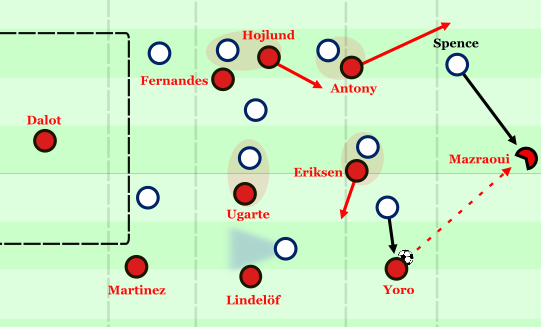
These movements demonstrated how Manchester consciously exploited Tottenham’s pressing to either generate depth through Antony or play wall passes to Højlund in the intermediate spaces. However, an issue arose with Mazraoui’s somewhat lackluster passing quality in the early stages, which caused the play into the intermediate spaces to lose some precision. Nevertheless, the patterns displayed considerable flexibility. This was particularly evident from the multiple occasions where switches to the far-sided wing-back were possible.
Tottenham, in their 4-1-3-2 formation against United’s centrally-focused 3-4-3, dropped deep to reduce the central distances. This, however, created space, especially for Dalot on the left side, who was occasionally found diagonally.
A recurring problem in these situations was Tottenham’s press on United’s wing-backs, which still involved a considerable pressing distance. With long balls, this gave the pressing player more time. As a result, United’s wing-backs were often directly under pressure and had to hold onto the ball. This, particularly for Dalot—whose first-touch issues have been noted several times—led to repeated difficulties.
Alternative patterns from ball-near movements
A deliberately used tactic that led to a goal-scoring opportunity in the 38th minute was the early movement to the wide areas close to the ball when it was with the centre-back. This strategically stretched the spaces within Tottenham’s defensive line, opening up areas for long passes into depth. These passes were often complemented by deep runs from Dalot, maintaining a 2v1 situation against the opposing full-back.
However, United often lacked additional depth from the center in these situations, as the numerous ball-near movements left the central space unoccupied. Moreover, Fernandes struggled with a slow dribbling pace, which made it difficult for him to assert himself consistently against Dragusin. A player like Diallo, with his dynamism and explosiveness, would likely have felt more comfortable in these situations and could have created more danger.
As against City, Manchester also displayed rotations between players in the half-spaces and wide areas. An example of this was the regular exchange between Mazraoui and Antony, which benefited the play. Antony brought a different quality to the build-up with his ability to seek and win 1v1 duels against Tottenham’s right-back Spence. On the other hand, Mazraoui focused more on passing solutions, thus structuring the sequences.
Through these rotations, Manchester aimed to bring more dynamism into the game while also manipulating Tottenham’s direct duels. At times, it became apparent that Spurs struggled with the transitions between players. This led to a lack of immediate pressure on the ball carriers, which allowed Manchester to win additional space.
Problems after the opponent’s adjustment
Ange Postecoglou responded quickly to the promising patterns in Manchester’s play and made tactical adjustments toward the end of the first half. The wide players of the 4-2-3-1, Son and Kulusevski, now positioned themselves much deeper than before, maintaining overall compactness. The focus of the pressing shifted: Instead of continuing to apply vertical pressure on the centre-backs, the wide players now specifically targeted the full-backs, Mazraoui and Dalot.
The Spurs’ full-backs increasingly focused on the dropping movements of the half-space players Antony and Fernandes, minimizing their influence on the game. At the same time, the Spurs’ centre-backs were able to better adjust to Højlund’s positioning, more effectively controlling his runs.
Especially Mazraoui struggled with this adjustment. Son’s direct pressure came from a lateral angle, with a cover shadow into the center, making it crucial for Mazraoui to turn. However, his ability to execute this turn was significantly hindered, which greatly affected the progression of play on this side.
Both struggled
The start of the second half was initially disjointed. A key factor was United’s continued reliance on long balls into Fernandes’ run. This idea seemed sensible given the promising moments from the first half but quickly lost effectiveness. Tottenham’s tactical adjustment, which led to a more compact defensive line, neutralized this option.
United also struggled to quickly regain possession after losing long balls. Tottenham exploited these weaknesses and gained momentum through the resulting transitions. Repeated turnovers in the wide areas, due to Spurs’ pressing, further hampered United’s control of the game.
As the match wore on, Tottenham began to falter. Their adjusted pressing lost effectiveness as United deliberately stretched the field, increasing the pressing distances for Spurs. As a result, Tottenham’s wide players in the 4-2-3-1 could no longer press United’s wing players consistently in a horizontal manner. Instead, the full-backs had to step out more often to regain control.
While these tactical shifts initially worked well for Tottenham, a major issue arose: when the wide player stopped pressing directly on the wing-back, the cover shadow into the center was lost.
This is where substitute Mainoo played a decisive role. Despite pressure from the opponent, he was able to receive the ball, hold off defenders, and release the also-substituted Diallo into 1v1 situations on the wing. Diallo used these opportunities to create dangerous situations with his dribbling strength and dynamism, opening up new offensive possibilities for United.
United’s push in the final stages was largely fueled by individual errors from Spurs and featured a clear characteristic: long balls. United tried to stretch the field by building deep and occupying the full height of the pitch. The aim was to create space for Fernandes or later Garnacho through ball-near movements in the half-spaces. This approach showed promise, especially after Zirkzee’s substitution, which brought new aerial duel and combination play options.
However, United’s efforts failed to create sustained danger due to numerous technical errors. Too often, possession was carelessly lost in promising positions. From a strategic perspective, United should have focused more on short-passing combinations at this stage. Tottenham revealed weaknesses in their hybrid pressing, particularly as the pressure on the wing-backs decreased. This gave the wing-backs more time on the ball, and with better runs in depth—particularly from Diallo—United could have put more pressure on Spurs’ defense in the closing stages.
Interim conclusion 3: United remains without a point in the third phase, following a winless period against the benchmark teams from Nottingham and London. Or—not entirely, as before the match against City, they secured a 3-2 win in Pilsen. Despite the victory, the game offered few new insights in terms of ball-related aspects—here, the game did not resonate extensively, as individual quality differences played a decisive role. However, here is a brief overview of the noticeable patterns:
- 3-2 build-up in the middle third: Casemiro frequently operated diagonally outside of Pilsen’s pressing wall (5-2-3), making him available in those spaces. The wingbacks and half-space players positioned themselves very high and dynamically formed pairs that dropped deeper to drag their direct opponents with them. The goal was to create diagonal passing lanes to the dropping Zirkzee. Zirkzee showed strong signs of link-up play in this match.
- Lack of depth from the wide areas: When the wingbacks dropped deeper, there was often a lack of depth from the wide areas. This was partly because Zirkzee preferred vertical movements over horizontal ones, leading United to consistently focus on central height occupation. Diallo from the half-space displayed similar movement patterns and rarely sought space in the wide areas.
- Diallo’s inward movement in build-up: In the middle build-up phase, Diallo repeatedly moved inside to create overload situations. These movements often allowed him to receive the ball in tight spaces. However, he struggled in these small-area situations in the center, which disrupted the flow of play.
Against City and Tottenham, Amorim tried several things again, such as positioning the wingbacks increasingly asymmetrically, which led to some progression issues into the wide areas during the derby—a step back, as this had not caused major problems until now. The same applied to the structurally deeper positioned half-space players, who were almost isolated in the early stages against City and lacked options for potential long balls.
However, it also became clear that Mainoo can be a gamechanger, as in both matches, it was his layoff passes under pressure that brought a certain dynamism to the Reds’ offensive play—he might have been a valuable starter. The adjustment to a 2-4 build-up against City was, overall, a very good decision, particularly essential for diagonal balls.
However, it became evident that Dalot seems somewhat uncomfortable with his offensive duties in both this match and the others, while Malacia appears to be not yet ready for the starting lineup. Had Dalot won some of the 1v1 duels, certain ideas and approaches might have appeared in a different light. Additionally, I am concerned by the fact that this team has extreme issues with its own, non-structurally created, flexibility. When Tottenham successfully adjusted their pressing at times, United had enormous difficulties and needed a break before things improved. This suggests that these players might also be affected by other negative influences (particularly in the physical and mental areas) that could explain certain tactical performances.
Phase 4: Already a Threatening Losing Streak?
After a generally mixed series with a win in the Manchester derby, elimination in the EFL Cup, and a solid victory in Pilsen, Ruben Amorim and Manchester United now face three opponents who, while generally winnable to improve the mood, are also known for their potential danger: Bournemouth, Wolverhampton, and Newcastle.
Manchester United v AFC Bournemouth (22.12 – 0:3)
The first game in this crucial phase saw Amorim face Andoni Iraola and AFC Bournemouth at home. Bournemouth is known for its extremely intense pressing in attack and midfield, so it was intriguing to see how United would respond to this pressure.
Difficulties against man-marking
United attempted to respond to Bournemouth’s aggressive pressing with a 2-4-3-1 shape in deep build-up. Knowing that Iraola’s team favored a strong man-marking system, Onana was frequently involved to create numerical superiority. At the same time, Maguire, as usual, stepped out from the centre-back position into the defensive midfield area alongside Ugarte. Bournemouth focused particularly on isolating Ugarte through a pressing triangle, effectively neutralizing him as a passing option. The passing lane into the pressure on Mainoo, a route United had been increasingly relying on in recent weeks, was also blocked by the cover shadow of the central striker. Additionally, Bournemouth tried to prevent United’s direct switches by employing a combination of “on-the-spring” defense from their fullbacks and cover shadows from the wide forwards in their 3-3-4 system.”
Bournemouth’s pressing system worked very well on this day, as United struggled to generate dynamism in their play. The wingbacks, Malacia and Dalot, played from deeper positions but were barely available for passes due to the cover shadows from Bournemouth’s players. Onana typically initiated play through the centre-backs, who were also under pressure. Bournemouth’s wide forwards immediately attacked the centre-backs, and with a short pressing path and vertical pressing direction, passing options were often limited.
Mainoo tried to respond to these patterns by dropping deeper from a higher starting position, aiming to drag Bournemouth’s central players out of position and create space in front of the defensive line for long balls. United regularly used these spaces with long passes but struggled to generate any real dynamism. The trio of Zirkzee, Fernandes, and Diallo was often positioned too narrowly, which made it easier for Bournemouth’s defenders to stay organized in their marking. Additionally, the positioning of the players in higher areas caused United problems when the second ball landed in the space between Bournemouth’s defense and midfield. Zirkzee struggled significantly in aerial duels, while Fernandes and Diallo naturally lacked heading strength. Consequently, United frequently lost the ball after long passes into the target zones, which allowed Bournemouth to build momentum.
By the middle of the first half, Onana’s increasing uncertainty became evident, as he showed more technical problems with receiving the ball and making passes. Mainoo tried multiple times to provide some impetus by pressing forward, but he couldn’t resolve the issues after losing second balls. Particularly, Bournemouth’s central defender Huijsen impressed with his strong heading ability, while Zirkzee continued to struggle in aerial duels. As a result, United was forced to search for alternative solutions.
Mainoo frees Ugarte
This dynamic, as so often this season, stemmed from a tactical adjustment by Mainoo. He increasingly positioned himself on the right side to engage Ugarte’s direct opponent, Christie. This allowed Ugarte to receive the ball in central areas, turn, and either play to the dropping Diallo or the advancing Fernandes. Ugarte benefited greatly from this setup, as he is strong in tight situations. It didn’t matter much if an opposing striker lost his orientation and marked Ugarte— as long as Ugarte had the game in front of him, he felt comfortable; when pressured from behind, however, he showed weaknesses. Mainoo ensured that Ugarte did not feel direct pressure from behind, which allowed him to be more effective in his actions.
The main issue, however, was less about freeing up Ugarte and more about the subsequent movements. On one hand, the decision to play into pressure was often poorly executed, as Diallo, as has been observed multiple times this season, struggled with ball control. This was evident again in this match, particularly because Kerkez was aggressive and defended well. Fernandes was occasionally sent in behind, but on the left side, he was often isolated. Mainoo’s movements to the right led to a lack of subsequent runs from deeper positions on the left side, which significantly limited Fernandes’ effectiveness.
Bournemouth continued to effectively close down United’s wide options through direct man-marking on Dalot and Mazraoui. United consciously avoided playing into these wide pressure situations—a clear lesson learned from recent weeks. This, however, left the team reliant on dynamism from the center, which was largely missing on this day.
Changes in the 2nd Half
Amorim appeared visibly dissatisfied at halftime and responded with a substitution, bringing on Yoro for the left wing-back, Malacia. However, Yoro took on the role of left centre-back, while Dalot moved from the right wing-back position to the left side. Mazraoui then took over as the right wing-back.
Bournemouth made tactical adjustments during the course of the match, switching to a flexible 4-3-3 formation. Cook or Ouattara would occasionally push forward to initiate the press. While the pressing structure remained similar to before, there was one key change: ball-far, either Cook or Ouattara would drop back to form a four-man defensive line with Kerkez, Zabarnyi, and Huijsen. The goal of this adjustment was to create a numerical advantage against Fernandes, Zirkzee, and Diallo in the defensive line, making United’s long balls, which had been frequently used in the first half, more effectively defended. This additional cover provided Bournemouth with more stability and minimized the threat of being bypassed by direct balls.
In the center, Bournemouth now adopted a tighter structure to consistently force Mainoo into a 1v2 situation. The ball-near central midfielder would shift diagonally toward the ball-carrying centre-back, blocking the passing lane into the center, while the other central midfielder would cover a wide area to isolate Mainoo. This strategy made it significantly more difficult for Mainoo to effectively drop deeper and influence the build-up, although at times, he was still able to hold off pressure.
It was promising, however, that Ugarte was able to frequently free himself from the cover shadow of the wide forward, particularly when that player pressed Yoro diagonally. This allowed Ugarte to make runs into the half-space, which worked in some situations. However, there were often no follow-up movements to capitalize on this advantage. On the one hand, Mazraoui was effectively neutralized by Ouattara’s isolation, preventing Ugarte from utilizing that route. At the same time, Mainoo was almost entirely neutralized by the 1v2 situation.
In many cases, the only available options were Diallo dropping deeper (something he struggles with) or playing a wall pass to Zirkzee, who, on this occasion, struggled significantly in that area. As the game wore on, Bournemouth also began to dissolve the man-marking system situationally to apply more direct pressure on Ugarte. Particularly, the overload on Mainoo was repeatedly nullified, shifting the focus more toward Ugarte’s movements. This led to Ugarte being under increased pressure, and the previously existing advantage began to fade.
It’s no coincidence that the focus of my analysis is on the deep build-up, as United, in their higher build-up, showed a rather hasty approach on the day. Time and again, the ball was played directly into the wide areas or forward, often resulting in directly playing into pressure. What was missing was a calm, controlled build-up to play out of pressure. The frequent long balls, in particular, allowed Bournemouth to gain more momentum.
Instead, United could have attempted to slow the tempo by holding the ball with the sole of the foot, provoking Bournemouth’s pressing in a non-committal manner, and then strategically exploiting the spaces that emerged. However, it seemed as though the team relied on repeated dropping movements, primarily from the wing-backs, to dynamically open up the half-spaces, aiming to penetrate through Zirkzee or Fernandes. This worked in isolated moments—such as in the situation around the 40th minute—but just as often, it led to simple, or even momentum-shifting, turnovers.
Overall, the performance was disappointing. There were hardly any tactical adjustments or changes, and the same problems persisted throughout the match. A notable issue was Mainoo’s near invisibility in the second half.
I would have liked to see him and Ugarte more involved in rotations. Mainoo’s dynamism and spatial awareness in the six-space would have added much-needed fluidity to the build-up, while Ugarte’s preference for tight situations in the offensive phase could have created valuable contributions.
There was also the recurring question of whether Maguire was properly positioned in the six-space. He often looked lost and was rarely involved in build-up play, despite opportunities for him to step forward. Instead, the focus remained almost entirely on Ugarte, which Bournemouth eventually anticipated and neutralized effectively.
Furthermore, there was a significant lack of rotations between the half-space players and the wing-backs, making the attack even more static and leaving United with few 1v1-focused options, especially in wide areas.
Wolverhampton Wanderers v Manchester United (26.12. . – 2:0)
After the disappointing defeat against Bournemouth, Manchester United’s next challenge was a match against Wolverhampton Wanderers. It was a duel against another relegation candidate, who, like United, has been searching for a clear identity for months. Both teams appear to be grappling with similar questions: Which manager can find the right answers to the structural and playing issues? Essentially, it presented the perfect opportunity for a breakthrough—or perhaps not?
…is this still a 3-4-3?
After the offensive struggles against Bournemouth, it was clear that an adjustment was needed for the match against Wolves. This adjustment was primarily seen in the altered movement patterns of Diallo and Fernandes, who played much more flexibly than in the previous game, occupying wider spaces.
Fernandes regularly moved out of his half-space position to act as a link player between the high-pressing Dalot and centre-back Martínez. Diallo, on the other hand, looked to occupy the half-space more from a central starting position, where, alongside Mazraoui, he could create overloads against Wolves’ full-back.
These adjustments were only made possible by Ugarte, who, through his dropping movements in front of Wolves’ pressing wall, occupied the ball-near wide player (aside: generally, dropping in front of the pressing wall against a 5-3-2 has become a trend over the past few months). This gave Diallo more space in the half-space and allowed him to position himself more effectively.
From his dropping movements in front of the pressing wall, Ugarte was frequently available for passes, as his direct opponent seldom actively sought the 1v1 duel. This allowed him to turn and distribute the ball effectively, such as to centre-back Mazraoui, who found himself in a 2v1 situation against Wolves’ full-back as previously described. This dynamic posed significant problems for Wolves early on, as the opposing centre-back was forced to step wide to defend the 2v1.
These wide pressing movements opened up spaces in depth behind the defensive line—an option that Diallo hinted at several times—but United initially made limited use of it. This was partly due to the Wolves’ wing-backs trying to close down the depth immediately with their pressing angles, which worked effectively in the opening minutes.
Another notable point was the general tendency of Wolves’ centre-backs to step far out of defense—this pattern appeared not only on Diallo’s side but also on the opposite side of the field. As soon as Fernandes moved into his intermediary position, Doherty also stepped extremely wide, sometimes even on the ball-far side, which created additional gaps in Wolves’ defensive structure.
A 2v1 also played a significant role on the left side during long balls, a side that had previously shown uncoordinated movements during long-ball distribution. However, the distribution here was noticeably better: Dalot was usually sought out in full width, while Fernandes, thanks to the 2v1, secured the second-ball zone without a direct opponent, preventing several turnovers. Højlund also showed a tendency to drift to the left side to bind a centre-back and prevent switches.
Especially through Maguire, who is known for his precise long passes, United was able to execute some good long balls, mostly stemming from more central build-up phases. As a result, they relied on depth in the wide areas. However, up until that point, Højlund had not provided enough depth. Later on, Mainoo did a good job of pushing up from the center, offering an additional passing option, which also led to some chances.
Ruben “lay-off-play” Amorim!
In this early phase, which was the best under Amorim so far, the lay-off play through Mainoo in the center worked very well, as he had already shown this skill earlier in the season. This lay-off frequently went to Ugarte, who then laid it off to Højlund. However, Højlund struggled to create anything in wall play under direct pressure from the opponent. Diallo repeatedly showed good intent to move into depth, but the passing angle was not available.
A general problem was that this pattern only worked when United used tucked-in half-space players to occupy Wolves’ central midfielders in their 5-2-3 setup, making the center slightly wider. However, when Wolves played tightly in the first two pressing lines, a lay-off pass became nearly impossible.
A very frequent pattern against Wolves was also Mazraoui tucking into the half-space. This was very sensible because Yoro, with his wide positioning, consistently dragged the outside winger out wide, opening up Maguire’s diagonal passing angle into the half-space. Mazraoui was played into this half-space multiple times, from where he could lay the ball off to the wide-positioned Yoro. Yoro then sent Diallo — who had swapped half-space positions with Mazraoui — into depth. In these moments, Diallo was able to exploit his speed and dribbling ability, which in turn created chances.
And then?
After a very good opening phase and generally a solid first half, with some chances created through the patterns described above, only the elusive goal was missing. Even the deeper build-up, which was seen only sporadically, appeared relatively stable in a 2-4 formation. Mainoo moved alongside Ugarte in the six, while the right centre-back Yoro acted as the right-back in the 2-4 build-up. Unlike in previous matches, Maguire played as a right centre-back, not as a central midfielder, which was noticeably different. In particular, Mazraoui could often drop dynamically, relieved by Yoro as right-back, allowing him to engage with Wolves’ man-marking. This movement repeatedly created good situations, from which United advanced offensively, usually through dribbling by Diallo.
However, shortly after the second half began, Bruno Fernandes was sent off. What had been a calm and thoughtful possession game quickly turned into a nervous, hasty style, increasingly focused on long balls. This shift was also due to Wolves pressing more intensively and with a higher focus on 1v1 situations, which created noticeable problems for United. Ultimately, however, they lost the match primarily due to their play without the ball — this will be discussed further in the next article.
Manchester United v Newcastle United (30.12. . – 0:2)
A few days later, all eyes were on Old Trafford. Could Manchester United carry over the good performance from the first half into the entire game, or would they fall back into old habits? It was an important match for the overall situation in the north of England.
2-3 build-up as the basis
United initially set up in a 2-3-1-4 formation against Newcastle’s 5-1-3-1 mid-block. This setup emerged because Martínez, similar to previous matches, pushed slightly wider and higher, effectively mirroring Mazraoui, the nominal wing-back, on the opposite side. Generally, Newcastle did not press continuously but instead applied selective pressure on Maguire and his teammates. However, their focus on marking the asymmetrical central pair of Casemiro and Eriksen resulted in the duo being largely isolated from the build-up play.
United primarily played around the pressing wall towards Mazraoui, as the wing-back’s pressing run from Newcastle’s 5-1-3-1 system on De Ligt was too far off to prevent a pass from Maguire to him. The diagonal pressing angle allowed the ball to often be played out wide to Mazraoui.
However, Newcastle’s pressing on that side appeared somewhat disjointed. The wing-back from the five-man defense pushed up very high on Mazraoui, while the centre-back had to shift wide to support Diallo. This often created pockets of space, but United failed to effectively exploit them, particularly through Højlund, who usually dropped into the center unchallenged due to the opponent’s man-marking on the midfielders, leaving the space in depth unoccupied.
On the opposite side, Zirkzee also preferred to drop into the half-space. Here, Casemiro’s movement wide was intentionally used to pull the winger further out, while Eriksen centrally linked with the number six to create space for Zirkzee. While this space was occasionally utilized, the Dutchman struggled to retain possession under pressure from the opposition.
Despite the available space, United often played into a defensive triangle formed by Newcastle, which quickly closed and intensified the pressure, leaving Zirkzee with no options. At times, the ball was played through Casemiro, who was able to turn due to the wide pressing angle. However, even in these situations, the tight man-marking of Newcastle’s wing-back on Dalot forced Casemiro to frequently opt for a backward pass.
Pattern after the early 0-2 deficit
United struggled after the goal, and as Newcastle gained more confidence, particularly when they adopted a more conservative and deeper defensive shape. In the 2-3 build-up, it became increasingly difficult to play the ball to the defensive midfielder. While he was sometimes able to turn, he faced a high positioning of players, characterized by covering shadows that funneled the play into pressure, along with tight man-marking that blocked passes to Dalot on the flank.
Additionally, striker Isak positioned himself in a way that denied any backward passes, ramping up the pressure on the ball carrier. This static structure made it difficult for United to generate dynamism, especially since Dalot is not a player suited for isolated 1v1 situations. As a result, no alternative options were available.
In response, Eriksen, who had often positioned himself on the last line, dropped in front of Newcastle’s pressing wall, now in a 5-4-1 shape, to provide additional creativity. However, this proved theoretical at best, as Newcastle remained extremely compact and tracked Dalot’s runs very effectively. There was an attempt to create new spaces through rotations between Mazraoui and Diallo, with Mazraoui now operating in the half-space and frequently shifting wide toward the ball. However, he often failed to push far enough toward the ball side to sufficiently weaken Newcastle’s defensive structure.
Also, problems persisted in the deep build-up.
This issue persisted in the deeper build-up, where Newcastle applied more aggressive pressure on the first line of build-up. They employed a man-to-man pressing system, creating 1v1 duels across the entire field – a situation that has traditionally been problematic for United. Particularly, Newcastle utilized a curved pressing run to direct the ball wide, with the striker making a circular movement while the wide player also engaged in the press.
This dual pressure created significant difficulties for United, particularly for Mazraoui, who faced intense 1v1 pressing. With tight man-marking applied across the entire field, the only viable option was to play the ball into the space between the lines to a dropping striker. However, these players, especially Zirkzee, struggled with wall passes and ball retention under immediate pressure. Consequently, United lost possession multiple times during the deep build-up, forcing them to rely more on long balls instead of progressing from the back.
Mainoo Brings Energy, Changes for the Second Half
After Zirkzee was substituted early, Ruben Amorim introduced Mainoo in his place. United transitioned from a 2-3 build-up to a 2-4 build-up, with Mainoo joining Casemiro in central midfield. Eriksen moved into the number 10 role, frequently positioning himself in the space between the lines.
Mainoo brought much-needed ball stability to the midfield, regularly receiving the ball under pressure. He demonstrated good composure, distributing the ball accurately, particularly to the wide areas. This adjustment helped United regain control of the game, although Newcastle’s pressing continued to pose a challenge.
Following the break, United shifted to a more traditional 3-1 build-up in the midfield phase. However, the issue of isolated high positioning remained largely unchanged. The three-man defensive line only extended the pressing route for the wide players, making it easier to play passes to Dalot or Mazraoui. Beyond that, options remained limited.
Mainoo repeatedly attempted to position himself in the space between the lines, as he had no direct opponent. He occasionally found space in this area but was only fully involved later in the game. Instead, United increasingly resorted to long balls aimed at Højlund to seek depth. However, given that Højlund is not known for his pace, he often struggled to chase down these passes, rendering this approach ineffective.
Towards the end of the match, United regained some dynamism, primarily due to the following factors:
- Garnacho moved into the left half-space and created good depth there. Width provider Dalot was able to play him into space a few times.
- Højlund continued to be sought in the space between the lines and was able to hold up play better, laying the ball off to advancing players like Mainoo.
- Antony, playing as a right-back, found it much easier in isolated 1v1 situations in the deep and middle areas than Mazraoui had. Winning direct duels against the man-marking put Newcastle under pressure, giving United more space to exploit depth.
- Yoro showed more courage in dribbling against Newcastle’s deep 5-4-1 and brought much more dynamism than relying solely on passing.
- Diallo frequently dribbled in tight situations and was able to break through the 1v1 matchups in wide areas.
Nevertheless, the result ended in a 0-2 defeat, primarily due to poor finishing quality and a lack of presence in the box, both of which need significant improvement.
So, this is how all the games of Phase 4 are lost – with disappointing periods of play, small setbacks, and a fair amount of bad luck. However, the first half against Wolves was encouraging: this type of controlled, structured – yet dynamic – football is exactly what Amorim wants to see. In contrast, the poor performance against Bournemouth must be seen as a low point under Amorim.
Despite justified criticism, it should be noted that Amorim’s system is still a work in progress. The fundamental playing idea already shows potential and appears well thought out in its early stages. Therefore, the weaknesses seem less about conceptual mistakes and more about the execution of the instructions. Several factors contribute to this, presenting greater challenges for Amorim.
The personnel situation at full-back is a key issue, forcing the coach to make frequent changes, which disrupts the stability of spatial occupation. Dalot, in particular, exemplifies these problems: his high positioning and limited technical ability in dribbling make it difficult to integrate him effectively into combination play. This not only destabilizes the build-up but also reduces the effectiveness of the counter-pressing, as the structures don’t always function properly in these situations. A similar issue applies to the strikers, who have struggled with wall play in recent weeks – a crucial skill Amorim needs to succeed against man-marking teams.
Additionally, there’s a lack of consistency in the build-up: promising approaches are often discarded too quickly under pressure, sometimes replaced by inferior options, causing United to fall into a hectic, uncontrolled rhythm. This impacts the overall structure and mentally burdens the players, especially given the dense match schedule, with no winter break and many midweek games. The demands of constantly operating at physical and mental limits seem to be overwhelming the team at present.
During these phases, the question inevitably arises – one that MR once posed in our chat: Is it really a good idea to entrust such a task to inexperienced (though extremely innovative) coaches? Amorim will likely only be able to answer this question with results. It remains to be seen how his journey unfolds.
Our analysis, however, continues: here follows the analysis of the game against Liverpool, and shortly the article on aspects of off-the-ball play and transition phases will be released.
MX made a name for himself in Regensburg with his preference for the objectification of the game. He flirted with the RB school but secretly remained a romantic for Guardiola’s football artistry. Currently, he works as an analyst in a youth academy (NLZ).
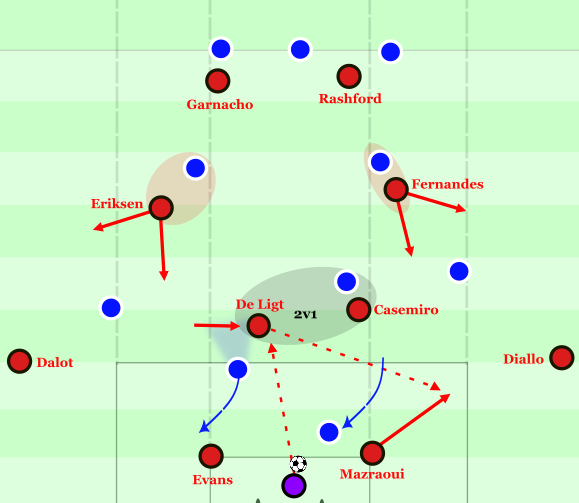
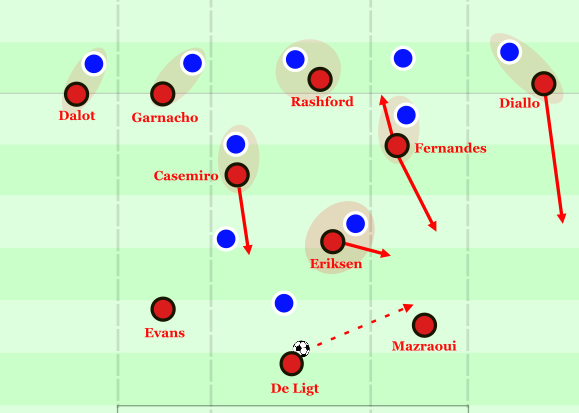
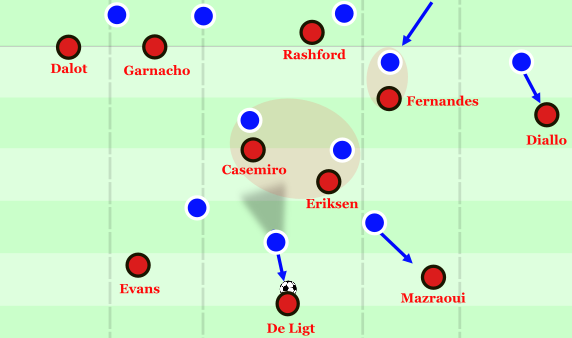
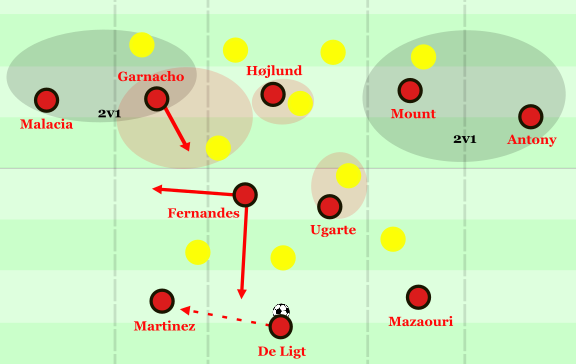
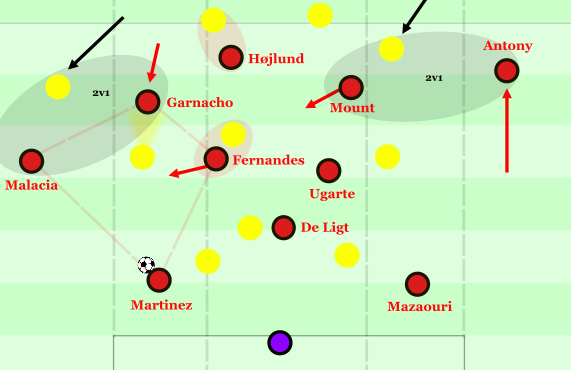
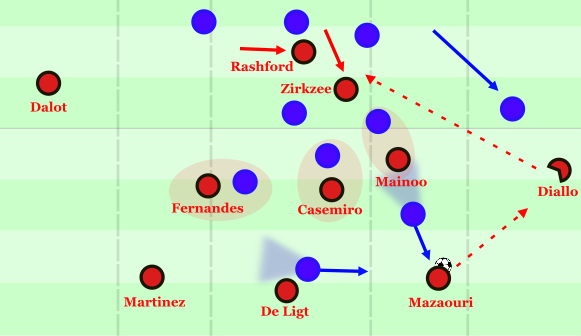
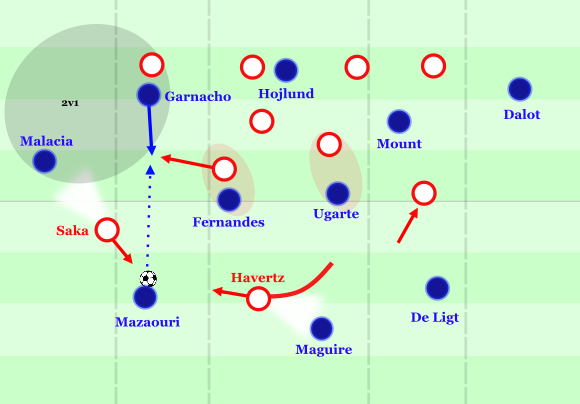
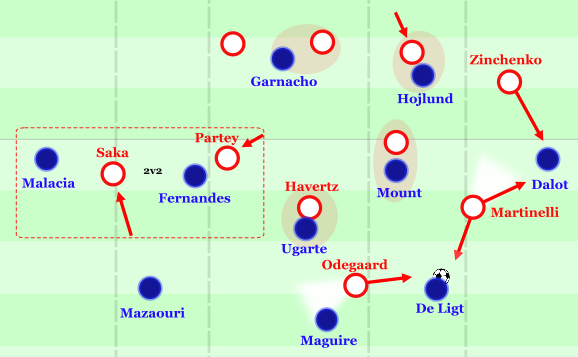
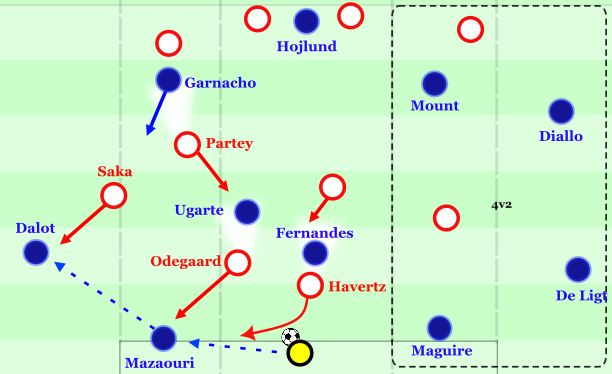
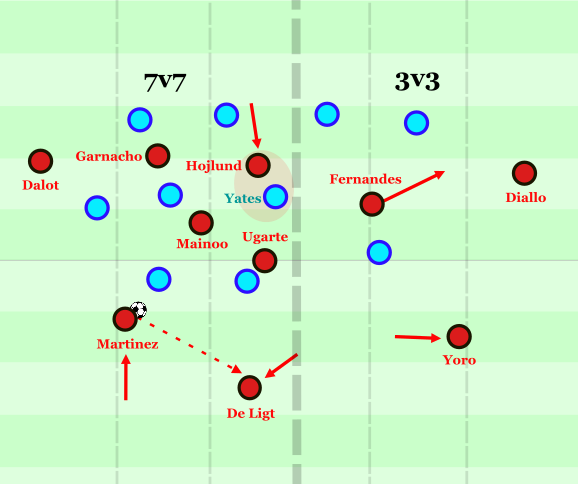
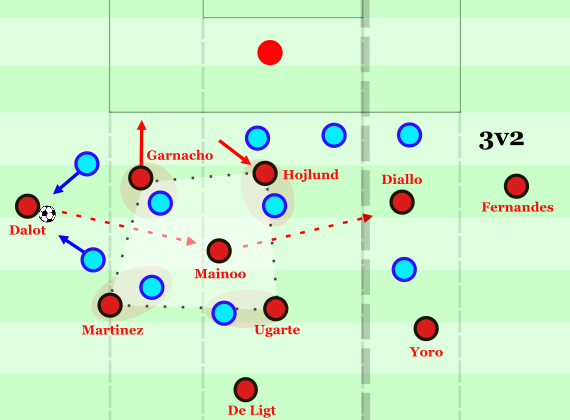
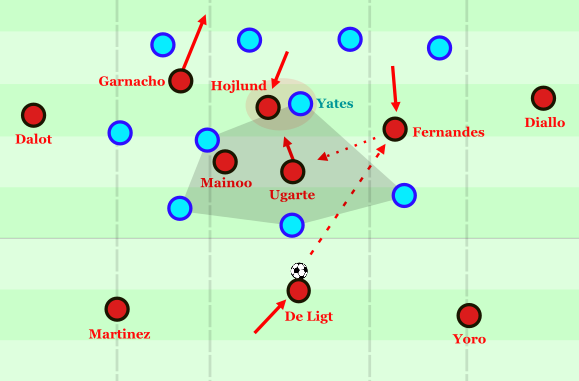
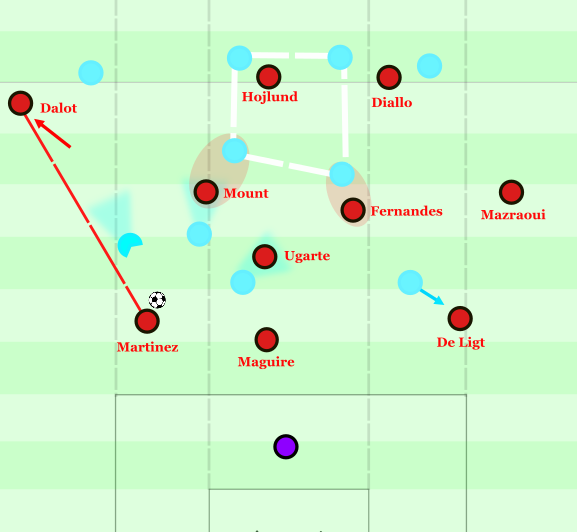
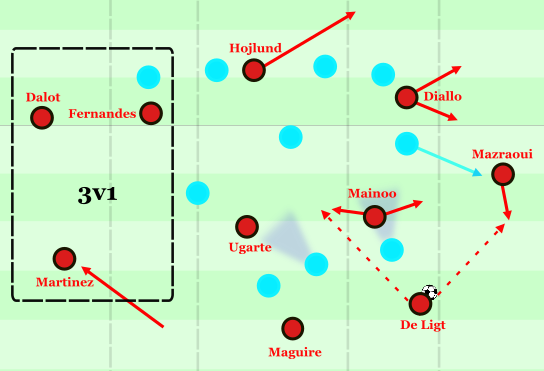
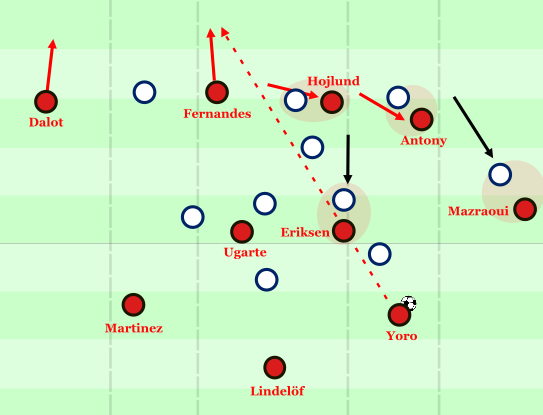
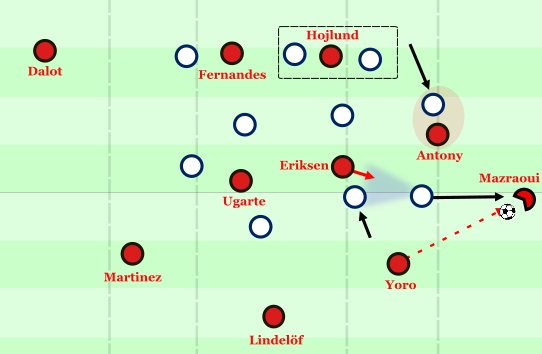
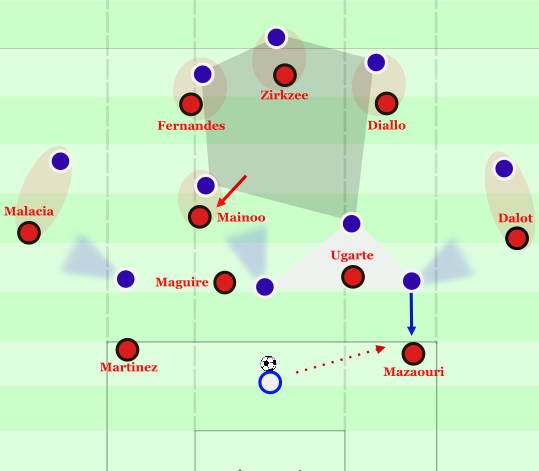
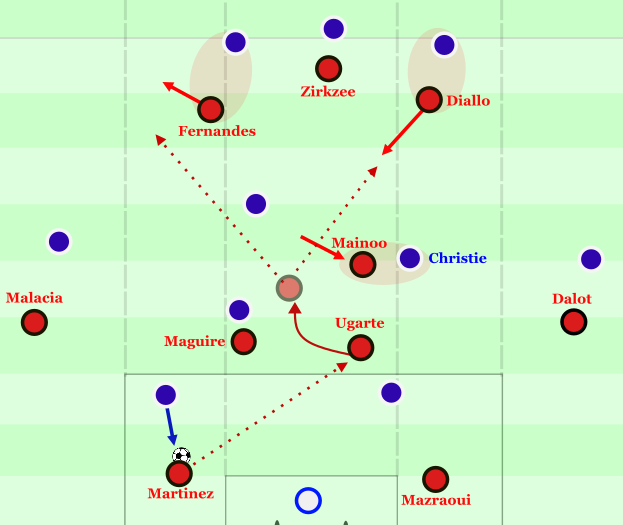
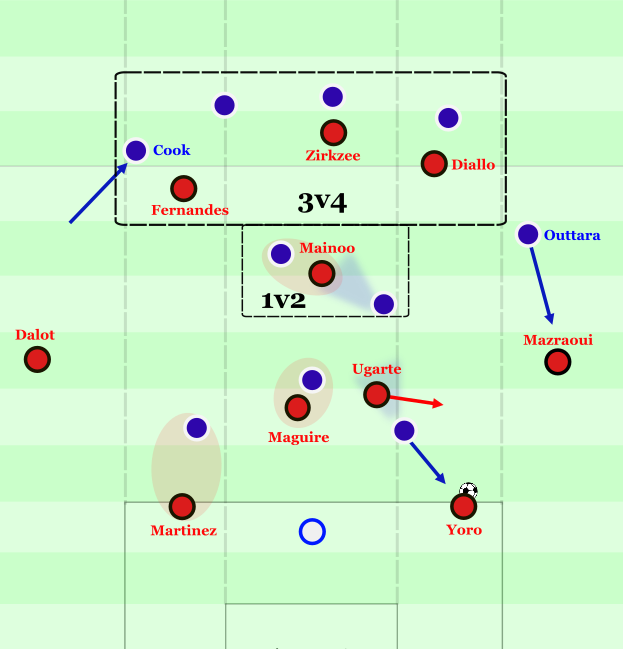
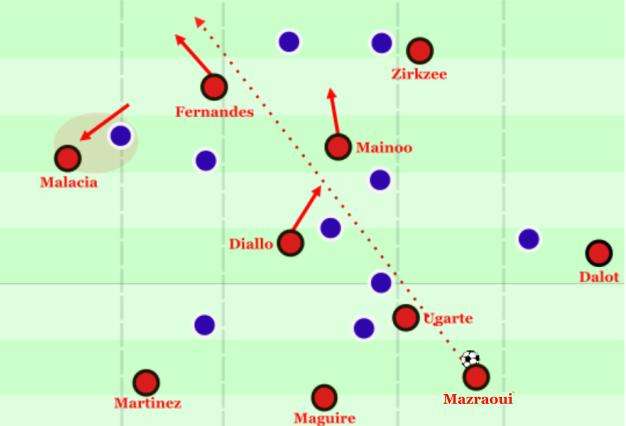
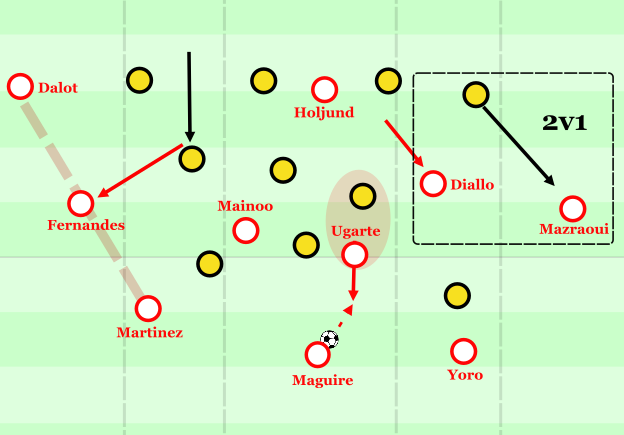
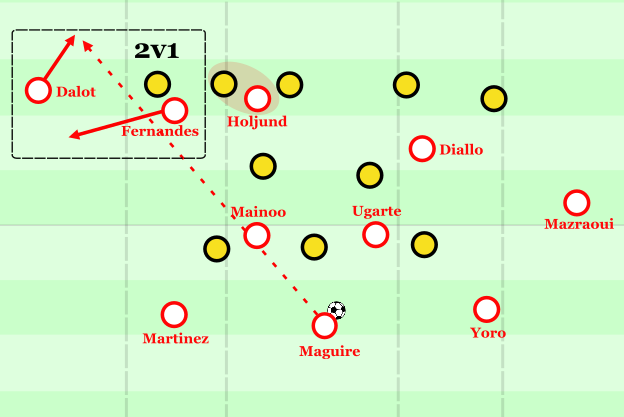
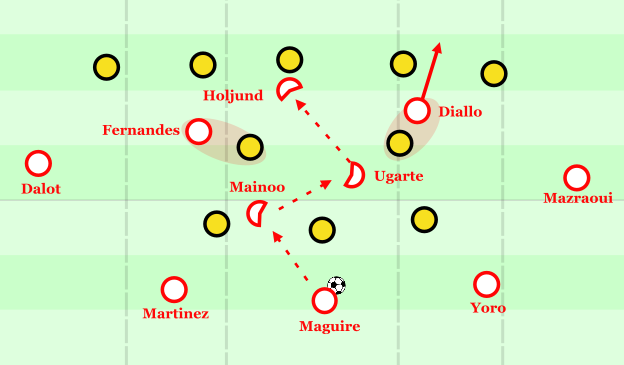
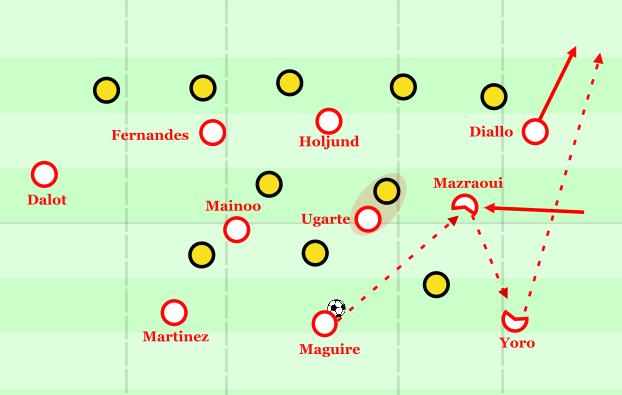
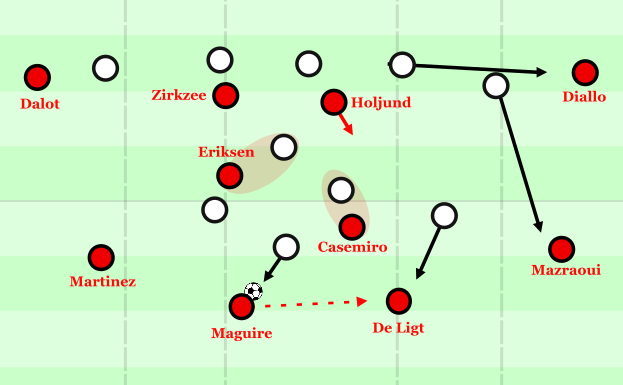
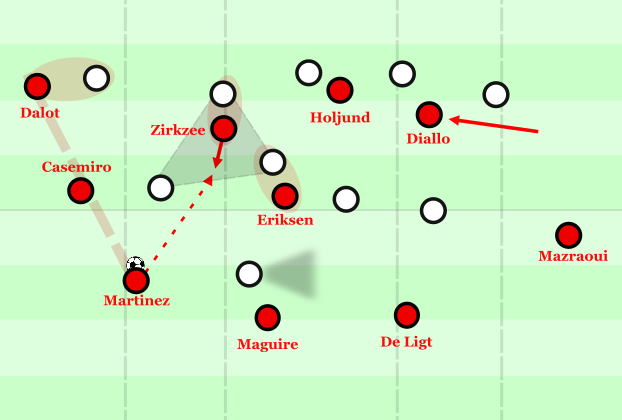
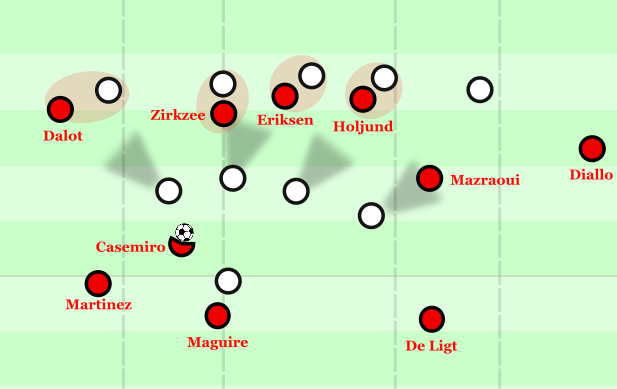
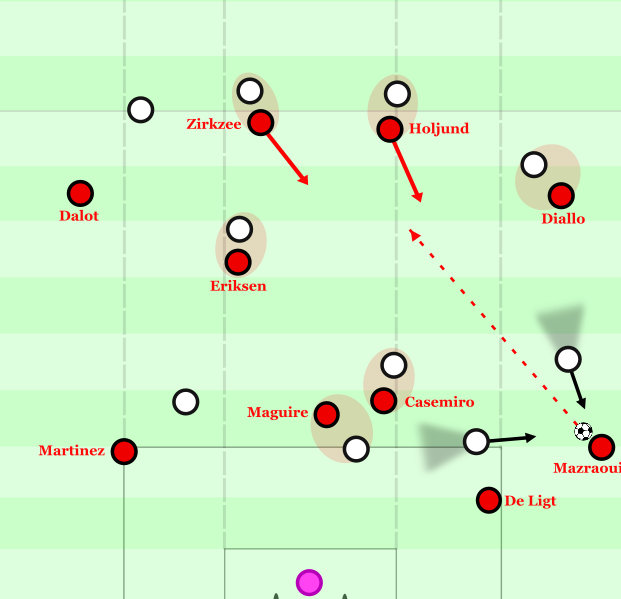
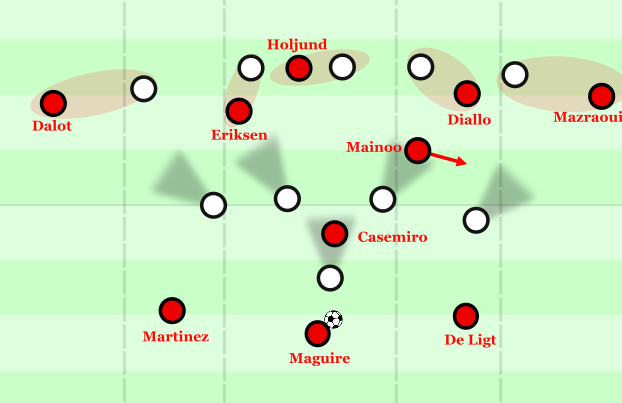
2 Kommentare Alle anzeigen
Ali January 15, 2025 um 3:19 pm
It was unique. I enjoyed this wonderful article word by word
James Mitchell January 15, 2025 um 9:06 am
What a game-changing article about United. Love it!
And: Please, more of this here again! 🙂